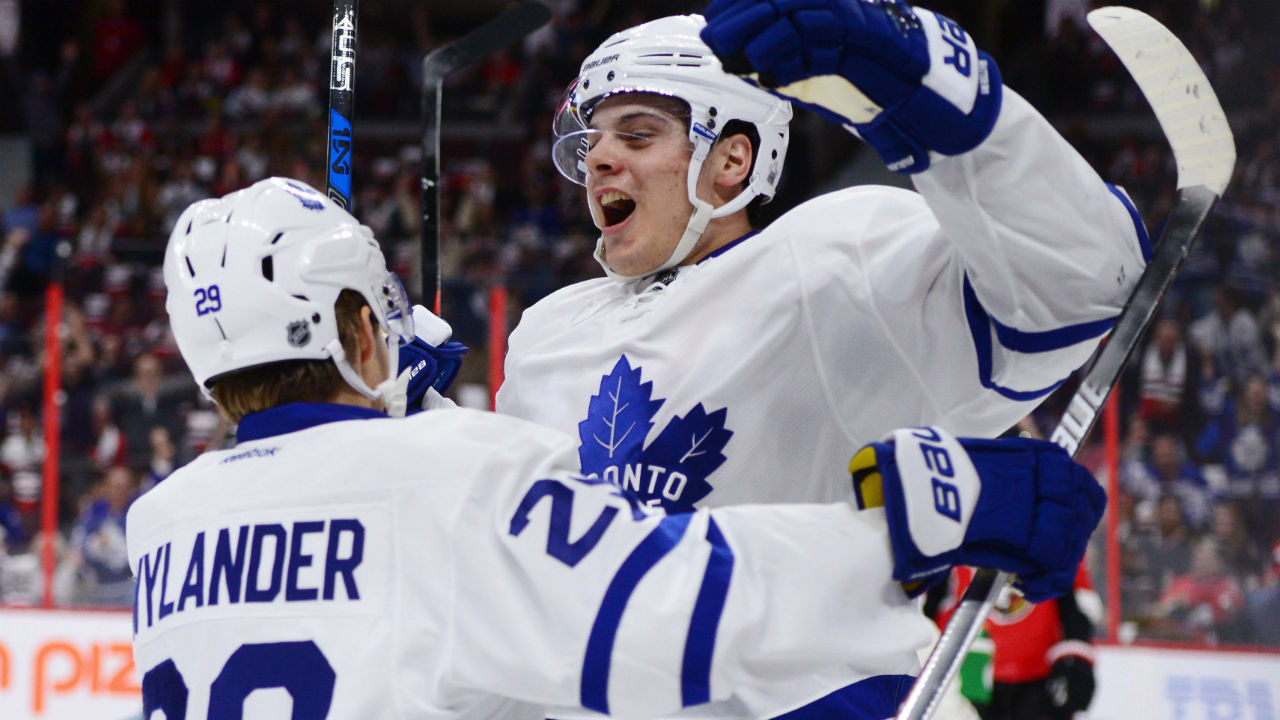We’ve now got almost a full week of the NHL regular season in the books. So what conclusions can we draw for the first few games?
The most likely answer: None. We can’t conclude anything. It’s only been a few games, and apart from a few injuries, chances are nothing that’s happened so far will really end up mattering. After all, we’re 36 games into a 1,230-game season. There’s more than enough time left for all of the early oddities and outliers to even out, and it won’t be long before we’ll probably have settled into a season that feels just like any other.
So yes, we can all agree that overreacting to the early results is foolish. But that’s too bad, because the first week has given us a handful of trends that it would be really cool to see continue over the rest of the season. We know it’s unlikely. But it’s hard not to hold out at least a little bit of hope that some of these temporary storylines will find a way to stick around.
So today, let’s look at a half-dozen early trends from the first week of the season that hockey fans should be hoping will continue, even though we know they probably won’t. At least we’ll be able to say we enjoyed them while they lasted.
Scoring is up
The NHL has spent the better part of two decades wringing its hands over an ongoing decline in scoring, without ever actually doing all that much about it. That continued this year when the league announced that they’d introduce smaller goaltending equipment, only to fail to have it ready in time for the season.
Maybe we didn’t need it after all. Through the first few games, average scoring is up by roughly half-a-goal per team. We’ve seen scores like 7-4, 6-5, 6-4 and then 7-4 again, and so far there hasn’t been a single shutout on the season (kind of).
Best of all, the increase hasn’t simply been caused by more power plays, like the 2005-06 spike that turned out not to last. And it’s all adding up an unusually high number of big comebacks. So what’s going on? It’s tempting to shrug it all off as just a quirk of small sample size, but that doesn’t seem to tell the whole story.
One theory points to the World Cup, which gave the league’s elite players a head start on playing meaningful games and let them hit the ground running. That makes sense, although it implies that the rest of the league should catch up relatively quickly. Or maybe we’re just seeing the next wave of young talent land on the league with a thud, bringing more speed and creativity than today’s defensive systems can handle.
That last one would be nice, but it seems overly optimistic.
NHL coaches have shown a frustrating ability to adapt their defence-at-all-costs approach to just about everything – if they could figure out a way to suck the life out of 3-on-3 overtime, it won’t take them long to work their way around whatever’s happening right now. But in the meantime, bring on the goals, and let’s consider it a preview of what the league might look like if it ever got around to the sort of changes that really could make the increase permanent.
McDavid racks up the points
Speaking of increased offence, Connor McDavid opened the season with back-to-back three-point games. Even after being shut down by the Sabres on Sunday night, that still left him tied for the league-lead, and on pace for a 164-point season.
It goes without saying that he won’t be able to keep up that pace – the only players to hit that mark are Wayne Gretzky and Mario Lemieux, and they could only do it in the offence-mad 1980s. But it’s worth wondering what McDavid’s best-case scenario looks like, both for this year and beyond. Is the Art Ross Trophy in play? Could he get to 100 points this year? Maybe even 110? More?
This would normally be the part where everyone would agree that we need to slow down and stop overreacting to a few good games. But this is McDavid we’re talking about here. He came into the league with more hype than any prospect in a decade, and he’s somehow looked even better than we expected. You watch him in action, and some of those old-school arcade numbers we’ve assumed were unreachable start to feel like they’re back in play.
The most points we’ve seen in a season during the cap era was 125 by Joe Thornton back in 2005-06. Jaromir Jagr totalled 123 that same season, and Sidney Crosby had 120 the following season.
Nobody’s managed more than 113 since then, and nobody’s even cracked 110 since Henrik Sedin in 2009-10. None of those numbers feel remotely unrealistic for a healthy McDavid at some point in his career. And that could come sooner than you might think – remember, Crosby’s best offensive season came when he was 19, the same age McDavid is today.
Again, nobody should be getting ahead of themselves in mid-October. But McDavid’s dominance isn’t some sort of short-term fluke, and there are nights when those 120-point seasons feel well within his range.
There’s a whole generation of hockey fans out there who have never seen a star player put up monster numbers over the course of a full year. It would be fun to experience that again.
The new concussion protocols seems to be working
On Sunday, we got our first look at the new league-mandated concussion protocols, in which spotters have increased power to order a player who appears to have suffered a head injury to be removed from a game.
It came in the Oilers’ loss to the Sabres, when goalie Jonas Gustavsson collided with Adam Larsson. A spotter notified the team that Gustavsson needed to come out, and the Oilers complied by sending Cam Talbot back out to finish the game.
What’s notable here is what didn’t happen. The Oilers didn’t ignore the order. Coach Todd McLellan made note of the situation in his post-game comments, calling it “strange”, but he didn’t really complain about it. And Oiler fans didn’t freak out, even though Talbot gave up two third period goals to turn a 4-2 game into a laugher.
Those are all good things. It’s how the system is supposed to work. And it would be nice if it worked that way all season long. But it won’t.
Eventually, we’re going to run into a spotter-related controversy. An apparent injury will be missed. Someone will get pulled from a game and then insist they were fine all along. A spotter’s decision will be ignored, which will flimsily be blamed on a miscommunication. Some team somewhere will latch onto a player’s removal as an excuse for a tough loss.
You know it’s coming, and probably sooner than later. But so far, an important step towards increased player safety is one-for-one. Let’s enjoy it while we can.
Canada is back
Last year, none of the Canadian teams made the playoffs. You may remember hearing about that. It was kind of a thing.
But nobody is expecting a repeat performance this year. In our Sportsnet panel, which featured many of the world’s most respected hockey reporters and also me, nobody picked the entire country to be shut out again, with guesses ranging from one to four Canadian teams making the post-season.
So far, the nation’s teams are exceeding even the most optimistic expectations. In fact, if the playoffs started today… well, it would be completely ridiculous, because we’ve only played a few games, but humour me here.
The point is, six Canadian teams would at least be tied for a playoff spot right now. That means something, right? We just need to ride out the last 79 games or so and we’re all set. Who’s with me?
No? Nobody. Yeah, I figured that was too soon. OK, let’s try one that still has a Canadian flavour, but narrows the focus a bit.
A Pacific shakeup
The Pacific has been by far the league’s most consistently predictable division over recent years. In three of the last four seasons, the Pacific has sent the same three teams to the playoffs: Los Angeles, San Jose and Anaheim. And heading into this year, most pre-season predictions had those same three teams on top yet again.
But heading into tonight’s action, the Kings and Ducks are both winless, sitting alongside the Flames at the bottom of the division. Only the Sharks have lived up to expectations, while the Oilers and Canucks have both shown signs that they could be better than advertised. Even the Coyotes started strong with a tough win over the Flyers.
Will any of it continue? It’s not completely out of the question – the Kings will be without Jonathan Quick for months, and the Ducks have looked like a mess under returning coach Randy Carlyle. The Coyotes and Oilers are stacked with young talent that could break through, and you’d have to think that the Flames figure things out sooner than later.
Or maybe not. We could be back to business as usual within a few weeks, with the California teams holding down the division’s top three spots and everyone else trying to catch up. But it would be nice to at least introduce some unpredictability into the division for a change, and early indications are that we might just see it.
The Maple Leafs are interesting again
If you’re a Maple Leafs fan, the season’s first two games have been exactly what you were hoping for. Sure, you’d prefer to be sitting with two wins, but that’s not really what this season is about.
This year is all about the kids, and finding out how many of them are for real. Building up the league’s best prospect pipeline was nice, but it won’t mean much if those top prospects can’t develop into NHL stars. So far, Auston Matthews, Mitchell Marner and William Nylander and the rest of the team’s young guns have all looked like they’re on the right track.
That’s not to say that we should expect those three to show up on the highlight reels every night for the next six months. The NHL is a tough league for rookies, and slumps are inevitable. The season can be a grind, young players often hit a wall, and injuries happen. But even if the numbers don’t hold up, you want to see occasional flashes that hint at a player being something special, and Toronto fans have already seen plenty.
So it’s been a good start for Maple Leaf fans. But the team’s early showing is also good news for all those fans who can’t stand the team.
Let’s face it, hating the Maple Leafs is always more fun when the team is at least a little bit competitive. Watching them collapse in the 2013 post-season was way more entertaining for Leaf-haters than seeing them meekly fade out of the playoff race by mid-January.
Would an improved Leafs team be relentlessly overhyped, with every minor story forced on fans across the country as headline news? Sure, but that was going to happen anyway. At least this year, they might be worth paying attention to.
It goes without saying that if and when Toronto becomes an actual Cup contender, Leafs Nation is going to be completely intolerable. But that’s still a few years away at best. For now, everybody wins.









